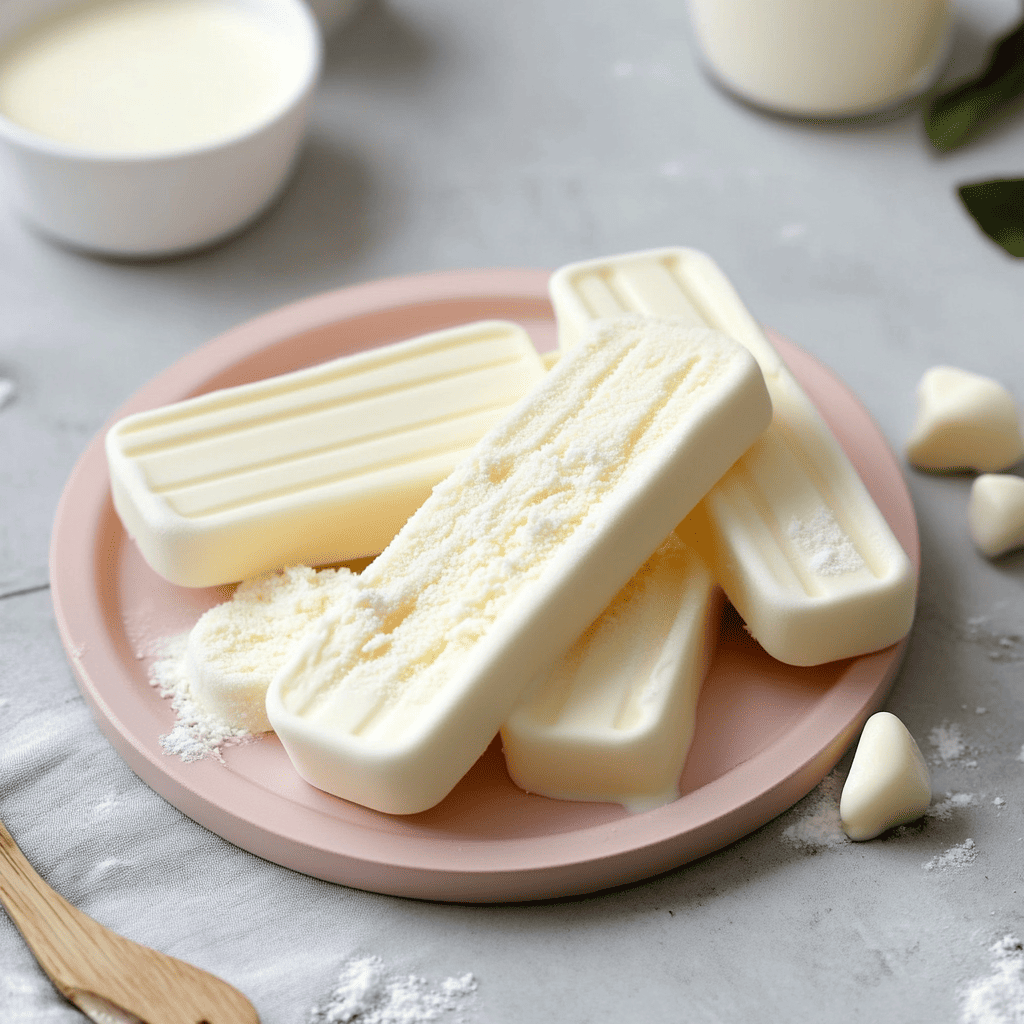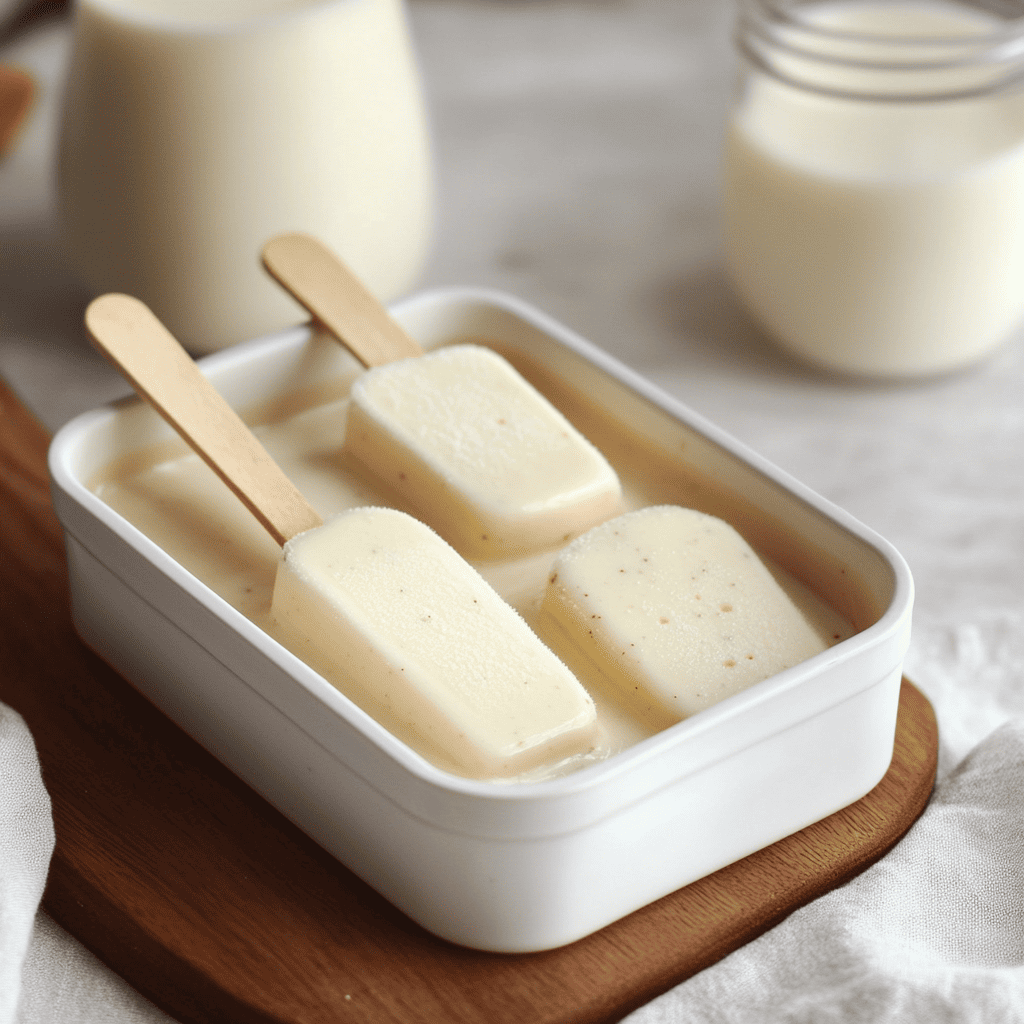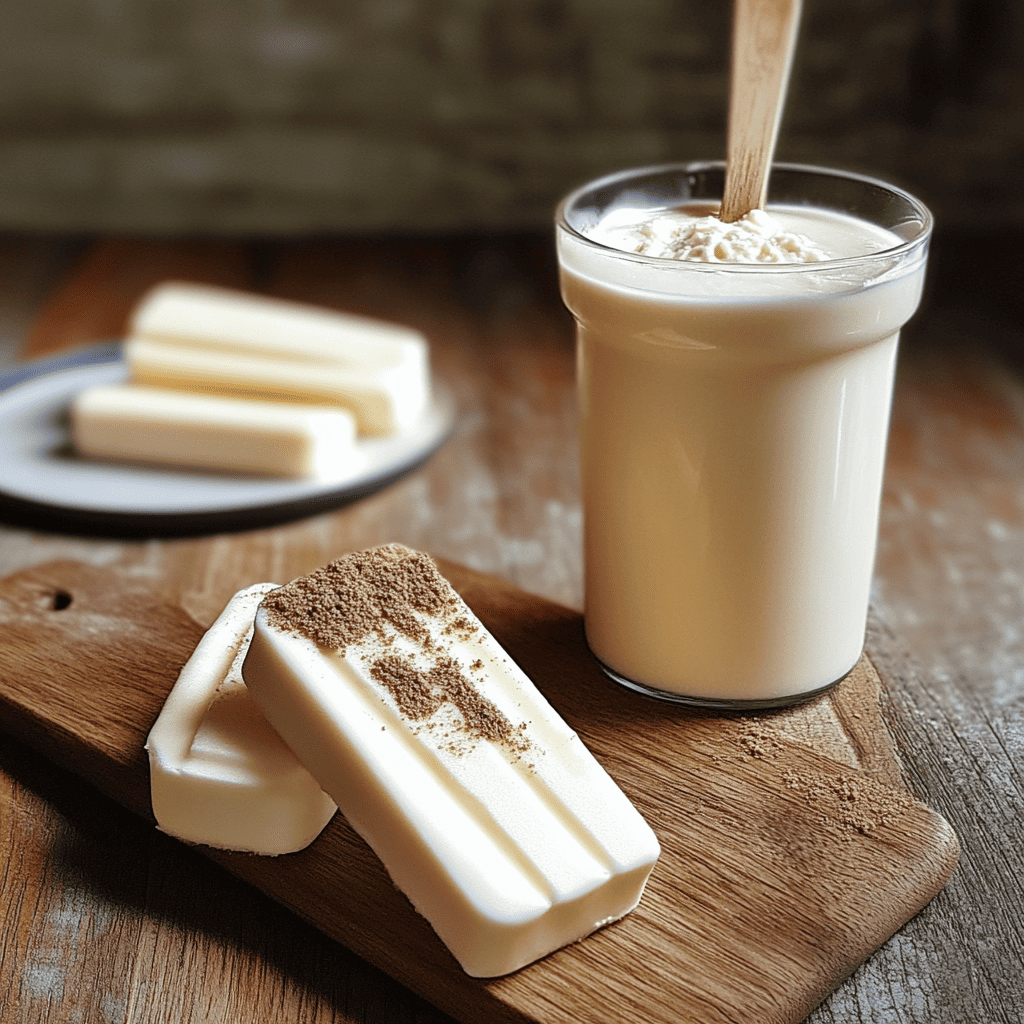Ultra Creamy Popsicles with Only 4 Ingredients: The Pleasure of Simplicity
Introduction
In a world where we often seek complexity in cooking, sometimes the greatest pleasures are found in simplicity. “Ultra Creamy 4-Ingredient Popsicles” epitomize this philosophy: a no-bake, no-fuss dessert with a surprisingly delicious result. Perfect for cooling off on warm days or satisfying a sweet tooth anytime, these popsicles stand out for their silky texture and delicate vanilla flavor, reminiscent of the homemade ice creams of yesteryear. The magic lies in the perfect combination of condensed milk, powdered milk, whole milk, and vanilla essence, transforming these humble ingredients into an irresistible frozen experience. Ideal for kids and adults alike, this dessert proves that indulgence doesn’t always require great effort.
Detailed History
The history of frozen desserts is as ancient as it is fascinating, and paletas are a relatively modern offshoot of this tradition.
The Origins of Ice Cream: The idea of cooling foods to preserve them or enjoy them as a delicacy dates back thousands of years. Ancient civilizations such as the Chinese, Persians, Greeks, and Romans already enjoyed “snows” or “frozen ices” made from ice or snow from the mountains, mixed with fruit, honey, and spices. Marco Polo is often, though erroneously, credited with introducing ice cream to Europe from China in the 13th century; however, recipes for frozen desserts already existed in Italy. During the Renaissance, ice cream became popular in European courts, and in the 17th century, the first café selling ice cream, the Café Procope, opened in Paris.
The Rise of the Popsicle: The invention of the popsicle, as we know it today, is attributed to an 11-year-old boy named Frank Epperson in San Francisco, California, in 1905. As the story goes, Epperson accidentally left a glass of soda with a stirrer stick on his front porch one cold night. The next morning, he discovered that the drink had frozen around the stick, creating a makeshift “popsicle.” Years later, in 1923, Epperson patented his “ice cream on a stick” under the name “Epsicle” and later “Popsicle,” a brand that became enormously popular.
Condensed Milk in Baking: Sweetened condensed milk, a key ingredient in these popsicles, has a history of its own. It was invented by Gail Borden Jr. in the United States in the mid-19th century. Looking for a way to safely preserve milk for travel and the military, Borden developed a process to evaporate some of the water from milk and add sugar, creating a sweet, thick, and long-lasting product. Its popularity grew during the American Civil War and it became a staple ingredient in home baking, especially in no-bake recipes like fudge, due to its ability to provide sweetness, creaminess, and stability without excessive heat.
Powdered Milk: Powdered milk also emerged as a preservation method, dehydrating liquid milk. Although used since the 19th century, its production and use became widespread in the 20th century, especially during and after the World Wars, as a dairy source that was easy to store and transport. In baking, powdered milk is prized for its ability to add body, creaminess, and a concentrated dairy flavor without excessive liquid volume, which is ideal for ultra-creamy textures in homemade ice cream.
Thus, this ice pop recipe is an amalgamation of culinary innovations: from the ancestral concept of frozen desserts, through the accidental invention of the popsicle, to the convenience of concentrated dairy products that revolutionized home baking.
More Historical Detail
The influence of condensed milk on Latin American pastries is particularly notable. Due to its availability and stability in warm climates where refrigeration was not always a given, condensed milk became a staple ingredient in countless traditional desserts. From flans and dulce de leche to gelatins and, of course, homemade ice cream, condensed milk provides the rich texture and distinctive sweetness that characterize many of these delicacies. Its ability to create a creamy base without the need for heavy cream or eggs (which require cooking) made it perfect for “no-bake” or “quick-assemble” desserts.
In the context of popsicles, the simplicity of combining condensed milk and powdered milk to achieve exceptional creaminess without the use of ice cream machines or complicated processes is a testament to culinary ingenuity. These popsicles are an example of how modern convenience ingredients, born out of conservation needs, can be transformed into simple and accessible treats for everyone.

Ingredients
Get ready to create magic with just four essential elements!
- 1 can of condensed milk (397 g)
- 1 cup of powdered milk
- 2 cups of cold whole milk
- 1 teaspoon of vanilla essence
Detailed Preparation
Creating these palettes is incredibly simple. Follow these steps for a perfect result:
Step 1: Preparing the Container and Utensils
- Make sure you have your popsicle molds ready. You can use individual molds, or if you don’t have any, small plastic cups or even large ice cube trays will work. If you use cups, have wooden sticks handy.
- You’ll also need a large mixing bowl and a hand mixer, stand mixer, or even a blender.
Step 2: Combine the Dairy Ingredients
- In a large bowl (or blender cup), pour in the entire can of condensed milk. The condensed milk will be the sweet, thick base for our popsicles.
- Next, add the cup of powdered milk. Powdered milk is the secret to the ultra-creamy consistency, as it adds milk solids without excess liquid, which helps prevent the formation of large ice crystals.
- Pour in the 2 cups of cold whole milk. It’s important that the milk is cold, as this helps the mixture emulsify better and reach the optimal temperature for freezing.
Step 3: Add the Vanilla Essence
- Add the teaspoon of vanilla extract. Vanilla not only adds its characteristic sweet and aromatic flavor, but also enhances the milky flavors of the mixture. You can adjust the amount of vanilla to your taste, or even use a scraped vanilla pod for a more intense flavor.
Step 4: Mix until homogenized
- Using a hand mixer (or stand mixer or blender), blend all ingredients at medium-high speed.
- Blend for at least 3-5 minutes. It’s crucial to blend until the mixture is completely smooth, with no lumps of powdered milk and a smooth, slightly frothy texture. The mixture should have a consistency similar to that of a light milkshake. Blending helps incorporate air, which also contributes to the final creaminess.
Step 5: Fill the Molds
- Carefully pour the mixture into the popsicle molds. Fill them almost to the top, leaving a little space at the top for the slight expansion that occurs during freezing.
- If you’re using plastic cups, fill them. If they don’t have the slotted lids, cover the tops with aluminum foil and then insert a wooden stick through the center of the foil into each cup. The foil will help keep the stick in place while freezing.
Step 6: Freeze
- Place the filled molds in the freezer.
- Freeze for at least 4-6 hours, or preferably overnight, until the popsicles are completely solid. Freezing time may vary depending on the size of the molds and the power of your freezer.
Step 7: Unmold and Enjoy
- Once the popsicles are completely frozen, to easily unmold them, you can quickly run the molds under warm (not hot) water for a few seconds. This will help the popsicle release from the mold without melting too much.
- Gently pull the stick to remove the lollipop.
- Serve immediately and enjoy its ultra creaminess and delicious flavor.
Estimated Preparation Time
- Active preparation time: 10-15 minutes (mix and fill molds)
- Freezing time: 4-6 hours (or overnight)
- Total estimated time: 4 hours and 15 minutes (minimum) to 12 hours (if frozen overnight)
Additional Tips
- Quality of Condensed Milk: Use a good quality condensed milk, as it is the main ingredient for flavor and sweetness.
- Powdered Milk: Don’t skip the powdered milk. It’s essential for achieving that extra creamy texture and preventing the formation of ice crystals, which can make popsicles grainy.
- Flavor Fusion: For a delicious variation, you can add other extracts or ingredients to the mix:
- Chocolate: Add 2-3 tablespoons of unsweetened cocoa powder to the base mix.
- Coffee: Dissolve 1-2 teaspoons of instant coffee in a splash of hot water before adding it to the mixture.
- Fruits: You can make a fruit puree (strawberries, mango, banana) and add it to the mixture, adjusting the sweetness if necessary. For a chunky texture, you can add small pieces of fruit after blending.
- Spices: A pinch of cinnamon, nutmeg or cardamom can add an interesting aromatic touch.
- Toppings: Once frozen, you can dip the popsicles in melted chocolate and then sprinkle with chopped nuts, sprinkles, or shredded coconut for an extra touch of fun and flavor.
- Storage: Once unmolded, the popsicles can be stored in individual freezer bags or in an airtight container in the freezer for several weeks.

Questions and Answers
Why aren’t my popsicles creamy and have ice crystals? This usually happens because I didn’t mix enough to fully dissolve the powdered milk and condensed milk, or because I didn’t incorporate enough air. It could also be that the ratio of liquids to solids isn’t right if you made a substitution.
Can I use skim or semi-skimmed milk? Yes, but the result may be slightly less creamy. Whole milk contributes to the rich, silky texture of the popsicles. If you use skim milk, you might consider adding an extra tablespoon of powdered milk.
Can I make this recipe without a blender or mixer? You can try mixing with a whisk, but it will be more difficult to completely dissolve the powdered milk and achieve a smooth, slightly aerated mixture. A blender or hand mixer is ideal for achieving the best texture.
How long do these popsicles last in the freezer? Properly stored in an airtight container, they can last up to 2-3 weeks in the freezer without losing much quality, although they are best enjoyed within the first week.
Can I use sweeteners instead of sweetened condensed milk? Condensed milk is crucial for texture and flavor. If you substitute it with evaporated milk and sweeteners, the result will not be the same in terms of creaminess and consistency. This recipe is based on the specific properties of condensed milk.
Texture and Flavor
These palettes offer a pure and pleasurable sensory experience:
- Texture: The name “ultra creamy” isn’t an exaggeration. The texture is smooth, silky, and velvety , melting in your mouth without the graininess or ice crystals often found in homemade popsicles. It’s similar to that of soft-serve ice cream or frozen dulce de leche, with a touch of stretch.
- Flavor: The flavor is predominantly sweet and milky , with a distinctive and comforting vanilla note . The condensed milk contributes a concentrated sweetness and a caramelized milk flavor, while the milk powder intensifies the dairy flavor. The vanilla adds an aromatic warmth that perfectly complements the dairy richness. It has a nostalgic flavor, reminiscent of pure condensed milk or homemade dulce de leche.
Consumer Context
Ultra-creamy popsicles are perfect for a variety of situations:
- Hot Days: They are the ideal refreshment to combat the summer heat.
- Casual Dessert: A delicious and easy dessert for any day of the week.
- For Kids: Their sweetness and creamy texture make them a guaranteed hit with little ones. Plus, since they’re homemade, you know exactly what’s in them.
- Children’s Parties and Celebrations: A healthier and more fun alternative to other processed sweets.
- Sweet Tooth: Perfect for satisfying a sweet tooth quickly and easily.
- After School/Work: A little treat to recharge your batteries.
- Ice Cream Alternative: When you don’t have an ice cream machine or want a portion-controlled, easy-to-serve ice cream.
Visual Aspect
The appearance of these popsicles is as simple as their preparation, but at the same time very appetizing:
- Creamy White Color: The popsicles have a white or slightly off-white color, suggesting milk purity and freshness. This uniform color indicates a well-emulsified mixture without crystals.
- Smooth and Shiny Surface: The surface of the palette is smooth and often has a slight shine, reflecting its silky texture and the presence of sugars and milk fats.
- Uniform Shape: The shape will depend on the mold used, but its consistency allows them to maintain a uniform and attractive shape.
- Elegant Simplicity: The absence of additional elements allows attention to focus on the promise of its texture and flavor, conveying a sense of purity and simplicity.
- Contrast with the Stick: The protruding wooden stick creates a visual and practical contrast, inviting you to pick up the popsicle and enjoy it.
Overall, its appearance is clean, appetizing and suggests a refreshing and delicious experience.
Curiosities
- Few Ingredients, Big Impact: This recipe is a great example of how a few basic ingredients, when combined correctly, can create a stunning dessert.
- The Magic of Powdered Milk: Powdered milk plays a crucial role in texture. By adding milk solids without water, it increases the density of the mix and reduces the amount of free water that could form large ice crystals.
- No Added Sugar (Extra): Beyond the condensed milk, no additional sugar is needed, which simplifies the recipe and ensures a balanced sweetness.
- Infinite Customization: Although the basic recipe is simple, it’s a perfect base for experimenting with countless flavors and additions.
- No Bake Dessert: This dessert falls into the “no bake” category, making it ideal for warm climates or for those who prefer not to use an oven.
Nutritional Value (estimated per serving)
The exact nutritional value will depend on the serving size (how many popsicles are made from the total mix) and the specific brand of condensed milk and powdered milk. Below is an estimate based on the full recipe divided into 8 servings (a standard popsicle size):
Estimated serving (1/8 of the recipe):
- Calories: 180-220 kcal
- Total Fat: 5-7 g
- Saturated Fat: 3-5 g
- Cholesterol: 15-20 mg
- Sodium: 90-120 mg
- Total Carbohydrates: 30-35 g
- Sugars: 30-35 g (mainly from condensed milk)
- Fiber: 0 g
- Protein: 6-8 g
Considerations:
- Sugar: These are desserts with a high sugar content, mainly from condensed milk.
- Proteins and Calcium: They provide a good amount of protein and calcium thanks to dairy products.
- Fats: They contain fats, mainly saturated, from whole milk and condensed milk.
As a dessert, it is recommended to enjoy it in moderation as part of a balanced diet.
Additional Benefits and Interesting Facts
- Source of Calcium and Protein: Thanks to the milk, these popsicles are a good source of calcium, essential for bone health, and protein, important for tissue growth and repair.
- Hydrating Snack: Although sweet, the milk component helps with hydration, especially in hot weather.
- Ingredient Control: By making them at home, you have complete control over the quality of the ingredients and can avoid artificial additives and colorings.
- Easy to Adapt to Diets: For lighter versions, you could experiment with low-fat milks (although creaminess will be compromised) or even plant-based milks for vegan diets (this would require a significant change to the recipe to maintain creaminess, perhaps using coconut milk).
- Family Activity: Making these popsicles is a simple and fun activity that can be done with children, teaching them basic cooking principles.
Other Information
- Molds: If you don’t have popsicle molds, you can use disposable yogurt cups or small plastic cups.
- Dripping: When serving, especially on hot days, have napkins handy, as creamy popsicles tend to melt more quickly than watery ones.
- Flavor Variety: To vary the experience, you could make half the pure vanilla mixture and the other half with another flavor, creating two-color or two-flavor popsicles.

Conclusion
“Ultra Creamy 4-Ingredient Popsicles” are a testament to the fact that culinary excellence doesn’t always lie in complexity, but often in purity and the perfect combination of simple elements. This easy-to-make, no-bake dessert with a heart-melting texture is a refreshing and comforting treat for all ages. From their humble, accidental origins to their ability to bring joy with every bite, these popsicles are a reminder that home cooking, with its authentic flavors and simple process, is often the most rewarding. Dare to make them and discover the pleasure of ultra-creaminess in every lick, turning a handful of ingredients into an unforgettable frozen experience.

